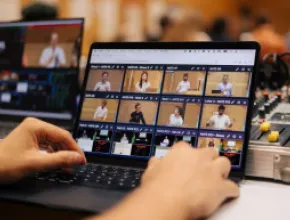Millennials are moving meetings tech. This biggest-ever generation may be young, but their expectations are changing the way attendees, planners and sponsors plan and execute events. Millennials aren’t just pushing the envelope, they are using technology to redesign the envelope.
Millennials are the first generation to grow up with the geyser of information and communications of the Internet. Most Millennials entered a world where information and communication were seemingly free, unlimited and as natural as breathing. Technological advances are as expected as sunrise tomorrow morning.
“You have 82 million people who were born into the upgrade cycle,” said Millennial and generational researcher Kim Lear during a recent presentation for PCMA. “We love to share what we love. Most of us, 87 percent, share our preferences and experiences online, in real time. What Baby Boomers and Gen Xers shared with family and maybe 10 friends we share with 3,000 people.”
That doesn’t mean catering to Millennials to the exclusion of older attendees. It means expanding planning horizons to include Millennials—which also accounts for the growing number of older attendees who are discovering the advantages of always being connected that Millennials take for granted.
“In business-to-business, you don’t have the luxury of targeting generations,” says Pat McClellan, chief strategy officer for Opus Events Agency. “You have to balance expectations. You also have to remember that Millennials are innately digital. They don’t think of their phone as a telephone. It is an extension of themselves and their world.”
The expectation that information is freely available and freely shareable has profound implications for event planners, presenters and sponsors. Facts are old news, mobile rules, and online access can never, ever fail.
Access, Access, Access
Few things are more frustrating than holding your phone and not being able to connect on demand. You can’t check e-mail, you can’t message colleagues, you can’t follow a presentation link, you can’t text a burning question for the Q&A session. That expectation of instant access may have started with Millennials, but it flashed through the rest of the population.
“I walk into meetings with 20-somethings to 60-somethings and they all have a smart device in their hands,” says Andee Oleno, director of marketing for technology provider PSAV. “The single-most important thing for all of them is strong, reliable Wi-Fi. Whether you are an attendee, an organizer or a presenter, you have to be able to connect reliably on multiple devices.”
Fast and reliable Wi-Fi is as essential as lighting, power and HVAC. Planners must ensure adequate bandwidth for their event. Many venues offer free Wi-Fi, says Kelly Peacy, CAE, CMP, senior vice president of education and events for PCMA. But depending on free networks is a recipe for frustration and unhappiness.
“Free is a euphemism for ‘somebody else is paying,’”says Ian Framson, director of sales for network provider Tradeshow Internet. “Bandwidth is a function of the type of event, your attendees, and the density of information flows. If you want quality Wi-Fi, you have to budget for it. You have to work out the details with your provider even if a sponsor is ultimately writing the check.”
Bandwidth lies at the root of the event technology conversation, says Meeting U founder and meetings industry tech speaker Jim Spellos. Most attendees, regardless of age, carry at least two devices; a phone and a laptop or tablet. A growing number carry three to five devices.
“Bandwidth needs are only going to expand as wearables become standard,” Spellos says. “For planners, ensuring adequate bandwidth is low-hanging fruit.”
How do you assess bandwidth needs? Peacy suggests starting with attendee and technology reports from last year’s version of the same event. Many network providers have free bandwidth estimators on their websites.
But don’t leave network details as an afterthought. Wi-Fi should be a standard element in every RFP.
“Tradeshow planners are getting there faster because they are more accustomed to negotiating services like power and water,” says consultant Jeff Hurt, executive vice president, education and engagement, for conference and tradeshow consultancy Velvet Chainsaw. “Attendees expect free Wi-Fi just like they expect free water. Savvy planners work this into their contracts. If you don’t, you can expect serious blowback from your attendees.”
PageBreak
The Paper Eclipse
The need for bandwidth spans generations, but less technologically adept attendees still want paper for registration, programs, announcements, handouts, abstracts, evaluations and other communications. Younger attendees want less paper.
“Millennials are looking to go virtual,” says John Chen, CEO of Geoteaming, a company that creates technology-based activities inspired loosely by geocaching for corporate events. “Some of it is wanting to go green, but they are already on their phones all the time. They want it all in one place, from registration through presentations to evaluations.”
That’s a challenge for planners. An all-mobile strategy is guaranteed to alienate attendees who expect paper for at least part of their information needs. Attendees who expect everything on their phone also expect everything to be personalized. Once they register via a mobile app, they expect to never see another registration pitch. Instead, they expect advance information on sessions, presenters and attendees that gets them involved in an event before it begins.
“It is not okay to have a clunky registration app,” McClellan says. “Millennials expect mobile first and they expect it to be easy and enjoyable. They expect to be able to download presenters’ slides now, not in a couple of days. They have grown up with equality and are not deferential to hierarchies. They expect access to organizational executives and presenters.”
Expectations of access include virtual access to key sessions. Free virtual access. They aren’t trying to skip out, Hurt says. They realize that just because you register for an event doesn’t mean you will be able to make every session.
“Millennials prefer face-to-face interaction, but they expect a digital alternative,” Hurt says. “They watch the Super Bowl free of charge and your event is no less important. If they can’t get there in person, they expect to participate electronically.”
Most events will continue using both paper and mobile apps for the next few years. Some attendees will never abandon paper, but their numbers are shrinking by the event. Planners should already be focusing on mobile first, Peacy says.
“Convenience is the key word for every attendee,” she explains. “At PCMA, our technology strategy revolves around engagement and connection. If you want to engage and connect, it has to be convenient. Nothing is as convenient as the mobile device you already have in your hand.”
New Conversations
Once upon a time, information alone was power. Sharing information created power relationships between those in the know—presenters, talking down to those who needed to know, attendees. Today, Google can search, find and present more information faster than any presenter.
“When I attend an event, I don’t want facts,” says Jamie Rooney, former website and live video manager for Weber Shandwick in Boston. “I can Google facts. I want experience and I want story.”
The days of “talking head” presenters are definitely dying, agrees Chris Washington, registration specialist for Attendee Management.
“We are more aggressive in our use of technology and have higher expectations,” he explains. “Technology can help the audience be more receptive and more responsive. When I’m in the audience, I want everything now. I want your presentation in my hand so I can follow links now.”
Millennial attendees expect a conversation, not a lecture, Hurt adds. They may not mind asking questions at a microphone, but it’s more convenient to text or tweet questions during a presentation. Attendees expect presenters to be able to deal with electronic questions and they expect answers both from the stage and from an electronic conversation that continues after the presentation.
“Any way you can integrate social and mobile, allow the voice of the attendee onto the stage, is a positive move,” Spellos says. “Putting the attendee front and center will go a long way toward creating a successful event.”






